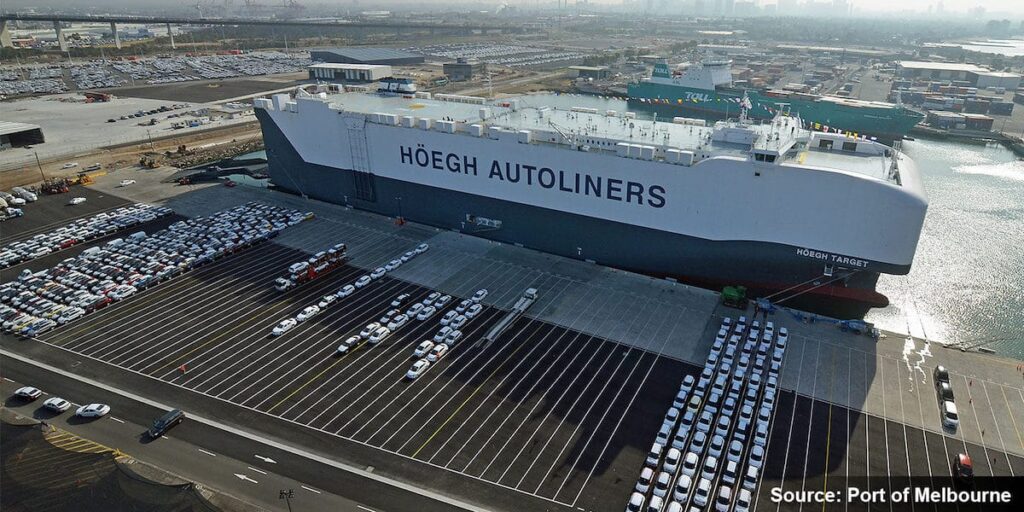
When shipping a trailer by sea, you have two main options for the shipping method: using a container or using roll-on/roll-off (RORO).
Each method has its own advantages and disadvantages, and the best option for you will depend on your specific needs and preferences.
Container Shipping Method
Container shipping is a method of transporting goods, including vehicles, by sea using standard shipping containers. A shipping container is a large, standardised container that is used to hold and transport goods by sea, rail, or road. Shipping containers come in various sizes, but the most common sizes are 20 feet and 40 feet in length.
In container shipping, the vehicle is placed inside a shipping container for transport. The container is then loaded onto a shipping vessel or truck for transport to the destination port or location.
The vehicle is protected from the elements and any potential damage during transport, as the container provides a secure and weather-resistant environment.
Container shipping is a convenient and flexible option for transporting vehicles by sea, as it allows you to ship other items along with the vehicle. You can pack the container with your vehicle and any other belongings you want to ship, such as furniture, appliances, or personal items, and ship them all at the same time.
Container shipping also allows for greater flexibility in terms of delivery options, as you can choose to have the container delivered to your door or to a specific location, and you can also choose to have the container picked up when you are ready to ship.
However, container shipping is generally more expensive than other shipping methods, such as roll-on/roll-off (RORO), as you need to pay for the cost of the container as well as the shipping itself. There are also size limitations for shipping a vehicle in a container, as the vehicle needs to fit inside the container.
If your vehicle is too large or too heavy, it may not be suitable for shipping in a container.
Overall, container shipping is a convenient and flexible option for transporting a vehicle by sea, but it is generally more expensive and may have size limitations.
It is important to carefully consider the pros and cons of container shipping and choose the option that best meets your needs.
Advantages of Using a Container Shipping
Using a container is a common method for shipping a trailer by sea, and it involves placing the trailer inside a shipping container for transport. The main advantages of using a container for shipping a trailer are:
-
- Protection: Shipping a trailer in a container provides a high level of protection against the elements and any potential damage during transport. The container protects the trailer from wind, rain, and saltwater, and it can also provide additional security against theft or tampering.
- Convenience: Shipping a trailer in a container is generally a more convenient option, as it allows you to ship other items along with the trailer. You can pack the container with your trailer and any other belongings you want to ship, such as furniture, appliances, or personal items, and ship them all at the same time.
- Flexibility: Using a container for shipping a trailer allows for greater flexibility in terms of delivery options. You can choose to have the container delivered to your door or to a specific location, and you can also choose to have the container picked up when you are ready to ship.
Disadvantages of Using a Container Shipping
However, there are also some disadvantages to using a container for shipping a trailer:
- Cost: Shipping a trailer in a container is generally more expensive than using RORO, as you need to pay for the cost of the container as well as the shipping itself. This can be a significant factor for those on a tight budget.
- Size limitations: There are size limitations for shipping a trailer in a container, as the trailer needs to fit inside the container. If your trailer is too large or too heavy, it may not be suitable for shipping in a container.
- Loading and unloading: Loading and unloading a trailer from a container can be more time-consuming and labor-intensive than using RORO, as it requires additional equipment and handling.

Roll-on Roll-Off (RORO) Shipping Method
Using RORO is another common method for shipping a trailer by sea, and it involves driving the trailer onto and off of a specialised shipping vessel.
Roll-on/roll-off (RORO) is a shipping method that involves driving a vehicle onto a specialised shipping vessel and rolling it onto and off of the vessel using its own wheels. The vehicle is secured to the deck of the vessel for transport and is usually covered by a tarp or other protective material to protect it from the elements.
RORO shipping is commonly used for transporting vehicles, such as cars, trucks, buses, and trailers, by sea. It is a convenient and cost-effective option, as it allows the vehicle to be shipped without the need for additional handling or cranes.
RORO shipping is also a fast and efficient way to transport large numbers of vehicles at once, as the vessels can carry hundreds or thousands of vehicles at a time.
RORO shipping is typically used for international shipping, as it allows vehicles to be transported between different countries and continents. The shipping process involves loading and unloading the vehicles at designated ports or terminals, and the vessels usually follow a set shipping schedule between different ports.
Overall, RORO shipping is a popular and convenient option for transporting vehicles by sea, as it allows the vehicles to be shipped without the need for additional handling or equipment.
However, it provides less protection against the elements and potential damage during transport than other shipping methods, such as container shipping.
Advantages of Using RORO Shipping
The main advantages of using RORO for shipping a trailer are:
- Cost: Shipping a trailer using RORO is generally less expensive than using a container, as you do not need to pay for the cost of the container. This can be a significant advantage for those on a tight budget.
- Size limitations: There are generally fewer size limitations for shipping a trailer using RORO, as the trailer can be driven onto the vessel without the need to fit inside a container. This makes RORO a good option for larger or heavier trailers.
- Loading and unloading: Loading and unloading a trailer using RORO is generally faster and easier than using a container, as it does not require additional equipment or handling. You can simply drive the trailer onto and off of the vessel, which can be convenient for those with limited time or resources.
Get a Quote
Choose Your Pick-Up and Delivery Locations to Get Started
Disadvantages of Using RORO Shipping
However, there are also some disadvantages to using RORO for shipping a trailer:
- Protection: Shipping a trailer using RORO provides less protection against the elements and potential damage during transport than using a container. The trailer is exposed to wind, rain, and saltwater during transport, and it is also more vulnerable to theft or tampering.
- Convenience: Shipping a trailer using RORO does not allow you to ship other items along with the trailer, as the trailer needs to be driven onto and off of the vessel. If you have other items you want to ship, you will need to use a separate shipping method or find a company that offers combined shipping services.
- Flexibility: Using RORO for shipping a trailer may be less flexible in terms of delivery options, as the vessel may not be able to access certain locations or ports. You may need to drive your trailer to a specific location for loading or unloading, which may not be convenient for everyone.
Overall, the decision to use a container or RORO for shipping a trailer by sea depends on your specific needs and preferences.
If you are on a tight budget and do not have other items to ship, RORO may be the more cost-effective option.
However, if you want to protect your trailer from the elements and have the convenience of shipping other items along with it, using a container may be the better choice.





